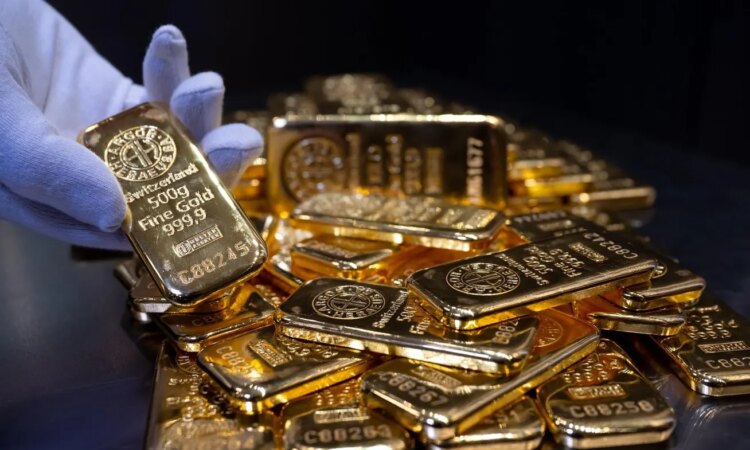
04 April 2025, Bavaria, Munich: Gold bars of various sizes lie in a safe on a table at the precious metal dealer Pro Aurum. Photo: Sven Hoppe/dpa (Photo by Sven Hoppe/picture alliance via Getty Images)
dpa/picture alliance via Getty Images
The price of gold fell over 5% today, its worst day in more than a decade. Even so, it is still above $4,100 per ounce. With the price of the commodity near an all-time high, is this the right time to invest? After all, we’re supposed to buy low and sell high, right? Here’s what you need to know if you currently own gold or are considering investing. Remember, gold doesn’t pay a dividend, so your return is based solely on its change in price.
Gold: Bubbles and Busts
Nothing rises forever and gold is no exception. Even though gold has risen substantially in recent years, at some point, its price will decline. Let’s look at history for perspective. Gold has experienced bubbles, which led to extended periods of underperformance. One such bubble occurred in the late 1970s when the price of gold peaked at $673.60 an ounce in October 1979. Then, gold fell 62% to a low of $256.10 by August 1998 and didn’t surpass the October 1979 peak until May 2006, over 26 years later.
Another period of underperformance began in September 2011 when gold peaked at $1,771.90 per ounce. It then fell nearly 40% to a low of $1,068.30 by December 2015 and didn’t surpass the September 2011 price until July 2020, almost 9 years later. Here’s the point. Periods of outperformance are usually followed by periods of underperformance.
Even though the price of gold has risen substantially in recent years, the average annual return from January 1978 through September 2025 was 6.03%. The average annual return for the S&P 500 Index over the same period was 10.79%. Thus, a $10,000 investment in gold would have grown to more than $95,000, while the same investment in the index would have exceeded $400,000. To be fair, stock returns were well above their long-term average during the 1980s and 90s and may not repeat it.
While gold has had lengthy periods of weak demand leading to severe underperformance, today, demand for gold is strong, which brings us to the bullish case.
Gold: The Bullish Case
Gold, like most investments, is affected by supply and demand. When demand is strong compared to supply, the price rises and when demand is weak, it falls. These days demand is strong and is expected to become even stronger in the near term. Who is buying gold and why?
Gold: Who is Buying?
If you’ve ever studied financial bubbles, you must admit it looks like gold could be the next one. Who’s buying gold? Retail investors (individual investors), institutional investors, central banks, industrial companies, and others.
Retail investors buy gold in ETFs, mutual funds, as well as physical gold like coins. This group also tends to rush in during the final stage of a bubble. After watching an investment rise for an extended period, coupled with an increase in media coverage, the individual investor will finally invest. Unfortunately, by that time, the bubble is often near its end.
Institutional investors also buy substantial amounts of gold. They are referred to as smart money investors because they often spot an investment opportunity before it becomes noticeable to the masses. Like individual investors, institutional investors also buy gold in ETFs and mutual funds. Currently, inflows into gold-backed funds are up 25% from a year ago.
Another source of demand for gold is central banks. In previous years, China sold more gold than it bought. In 2024, China, Poland, and others bought significant amounts of gold.
Industrial companies are also buying gold. Gold is a great conductor, and it resists corrosion. As such, it is used in circuit boards, smartphones, computers, semiconductor chips, and more. Other areas of demand are found in the aerospace, healthcare, and automotive sectors.
Gold: Time to Buy or Sell?
Now for the million-dollar question: is it time to buy or sell gold? Is the bullish case stronger than the bearish case? Given today’s 5.5% loss, perhaps a brief downturn is due before gold trends higher. Hence, this could be a buying opportunity for those who are not invested in gold.
Gold: Another Source of Demand
Again, when demand exceeds supply, the price of gold rises. I mentioned retail investors, institutional investors, central banks, and industrial companies, are all buyers of gold. A key reason for the increase in demand for gold is fear. People and governments around the world are fearful over the current tariff turmoil. You see, the U.S. is the largest economy on earth by a wide margin. As such, our economy is extremely resilient and can withstand a great deal. Smaller, foreign nations, on the other hand, have more fragile economies and tariffs could be problematic to these countries, not that the Trump administration would let it come to that.
Even if gold continues to rise, there will come a point when it peaks, then falls. Remember, the larger the bubble, the greater the downturn. Does today’s decline point to the end of the rise in gold? If today’s decline is due to profit taking – which is healthy after a significant rise, then no, the rise isn’t over…… yet.





